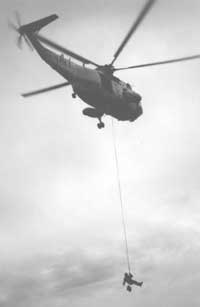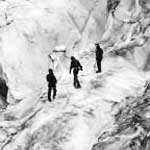|
North Cascades National Park Service Complex Climbing Notes 2002 |
National Park Service U.S. Department of the Interior |

|

| 2001 Search and Rescue Incidents |
 Whidbey Island Navy helicopter search and rescue team training with NPS Rangers. In 2001 search and rescue personnel responded to 18 incidents including a fatality on Mt. Baker. NPS photo |
North Cascades National Park's search and rescue personnel responded to 18 incidents in 2001, including assistance given to the Whatcom County Sheriff's Office with two incidents on Mount Baker.
The total unprogrammed emergency cost to the National Park Service was $15,225, of which 47% was for contract helicopter services. These figures do not include costs assumed by military and volunteer programs that also work on Park incidents.
The 2001 accidents were consistent in the long-standing trend that the majority of climbers evacuated are injured in the non-technical approach or descent, not the actual climbing routes.
Also noted in 2001 was that more trail hikers were injured and evacuated than those with mountaineering objectives.
Five of the 2001 incidents are summarized below.
Klawatti Glacier, May 22
A ski-mountaineering party reported a non-critical, but disabling knee
injury to one member. The skier had taken a slow, tumbling fall near the
base of Klawatti Peak after a descent of Klawatti's south face. He was
evacuated by helicopter to Marblemount.
Quien Sabe Glacier, July 14
A climbing party was descending the Quien Sabe Glacier when one climber
punched through a snowbridge, falling onto rocks and injuring an ankle.
He was unable to continue so party members carried him to flatter ground
and alerted rangers via cell phone. The climber was evacuated to
Marblemount by helicopter.
Goode Mountain, August 1
Two climbers were below the Goode Glacier en route to ascend the NE
Buttress when ice fell from above their location, slid across snow, hit
rock, then showered the climbers with football sized chunks of ice. They
had heard the icefall and were scrambling to take cover when they were
struck. Both suffered minor injuries, including a crushed hand, but they
were able to extricate themselves, provide self first-aid and hike out
to the Stehekin ranger station for further treatment.
Bacon Peak, August 7
A climber on Bacon Peak's north side slipped on steep ice while
travelling with a full pack. The fall was arrested in a rocky area and
he absorbed most of the impact on his head.
The group continued travel for several hours, but when the injured climber's neurological functions deteriorated a ground-to-air radio transmission eventually alerted park rangers.
The climber was evacuated to a hospital and treated for a skull fracture.
Mount Baker, September 2
Four climbers on one rope were ascending Coleman
Glacier when one member slipped on steep ice at 8600'.
All four climbers were pulled off their feet, slid down the icy section, cleared a large open crevasse and landed on a narrow ice shelf.
| Interested in climbing condition reports? |
|
So is the Wilderness Information Center in Marblemount! While rangers themselves send in reports from their daily patrols, all climbers are encouraged to report firsthand findings through one of several avenues:
|
The one uninjured member left to summon assistance, leaving at the scene one climber with minor injuries, one semiconscious climber with serious spinal and leg injuries, and one member who likely died upon impact in the fall.
NPS rangers and an ER physician (volunteer Mountain Rescue member) were flown to the scene.
The critically injured climber was helicopter short-hauled 2000 feet down, off the glacier. The remaining climber was assisted down to a bivouac for the night.
Impending darkness, high winds and an oncoming storm precluded flying the injured completely off the mountain.
Volunteer mountain rescuers carried in supplies through the night to sustain the ER doctor's efforts with the critical patient. The next day, several western Washington Mountain Rescue Association units and rangers conducted an overland carry-out to the trailhead due to the continuing storm.
The fatally injured climber was recovered several days later.
| Blue Bags — use them to reduce your impact |
Climbing rangers continue to find piles of human waste when patrolling at snow, glacier and rock camps.
To say the least, the presence of human waste on snow or in the rocks around your camp is visually offensive, unpleasant and possibly a serious health hazard.
The NPS has addressed the issue with toilets in some areas, but this is obviously not feasible for all climbing destinations.
At the Wilderness Information Center in Marblemount (and some other stations where permits are available) you can pick up blue bags or the more deluxe WAG bag free of charge.
The WAG bag contains biodegradable plastic bags, hand towelettes and a gelling powder to solidify the waste.
While North Cascades National Park has no specific collection facilities, these bags (with waste) have been approved for disposal in any proper waste receptacles in Skagit and Whatcom counties.
Use of the bags is especially encouraged for snow camps on the Sulphide Glacier prior to compost toilet melt out, (about mid-July) and on the approach to Eldorado (year-round).
 The Chopping Block — NPS photo |
 Coleman Glacier — ©Greg Mroz |
 Mount Shuksan — NPS photo |
| Addressing Wilderness Climbing Impacts |
Rangers of the North Cascades National Park Wilderness District have measured and inventoried human impacts in "trailless" areas of the park since its establishment.
Methods have varied and progressed with recent efforts including the use of GPS mapping and measuring miles of access routes with digital cameras and measuring tape.
This documentation of climbing trails and camps is done in accordance with the Park's Wilderness Management Plan, which has a goal to limit and even rehabilitate the human impacts. The plan was approved in 1989 after much of North Cascades National Park was designated by as Wilderness.
During the summer of 2001, patrols were conducted in areas such as the Picket Range, Inspiration Traverse, the Sulphide Glacier approach to Mount Shuksan, and Triumph Col in order to update previous years' inventories.
In addition to the anticipated bivy sites and climbers trails, a surprising number of firerings were noted, and subsequently removed. Fires in subalpine areas leave long-term scars and are only allowed in designated low elevation camps. The firerings were found in very remote areas, such as the headwaters of Access Creek, the margins of the Challenger Glacier and Triumph Col.
The North Cascades Wilderness Committee continually reviews and discusses options to address human impacts in off-trail areas. Topics of discussion in 2002 include:
Further restrict use. A permit system that limits the numbers of parties allowed in each cross-country zone has been in effect for many years. One consideration for preventing impacts is to lower the number of parties allowed in areas where statistics show a correlation between amount of use and impact.
Restoration of cross-country impacts. Parts of the seriously gutted climber's trails into Boston and Eldorado Basins have been rerouted and restoration attempts are in progress. If funding and policy challenges are met, this type of effort might be expanded to other cross-country areas.
Expand efforts to promote Leave No Trace principles. Not just the amount of use but also the type of use plays a dramatic role in wilderness impact. The key LNT considerations for climbers are camping on rock or snow, not trampling fragile vegetation, limiting party size, managing waste and using a stove.
Notification of backcountry emergencies by cell phone is no longer an unusual occurrence, although reception in mountain areas is far from dependable. Rangers at the North Cascades National Park neither advocate nor discourage packing a phone on a climbing trip. Cell phone distress calls have had positive and negative results. In a number of incidents, phones have successfully alerted rescuers to mountain accidents, allowing rescue to begin hours earlier than it would normally. Just as often, however, poor reception has resulted in confusing communication, and unnecessary responses.
|
The Recreation Fee Demonstration Program remains in effect for most land management agencies. North Cascades National Park participates through the Northwest Forest Pass. Parking areas for all climbing destinations along the Cascade River Road and the Sulphide Glacier approach to Mount Shuksan (among others) require a pass. The Northwest Forest Pass is available at most ranger stations. Park officials are also exploring ideas to standardize the backcountry permit, reservations and fee programs between North Cascades, Mount Rainier and Olympic National Parks. While backcountry permits for any overnight camping have been in effect for decades, no fee or reservation system for the general public currently exists at the North Cascades National Park. Rangers are interested in your thoughts about the possible addition of fees and/or reservations for permits. Climbers are encouraged to inquire at the Wilderness Information Center. Northwest Forest Pass The Northwest Forest Pass is available at most Forest Service or Park offices, via phone (1-800-270-7504) and online at www.naturenw.org. An annual pass costs $30 and a day pass costs $5. |
A PDF version is also available.
noca/climbing-notes/2002.htm
Last Updated: 28-Oct-1998